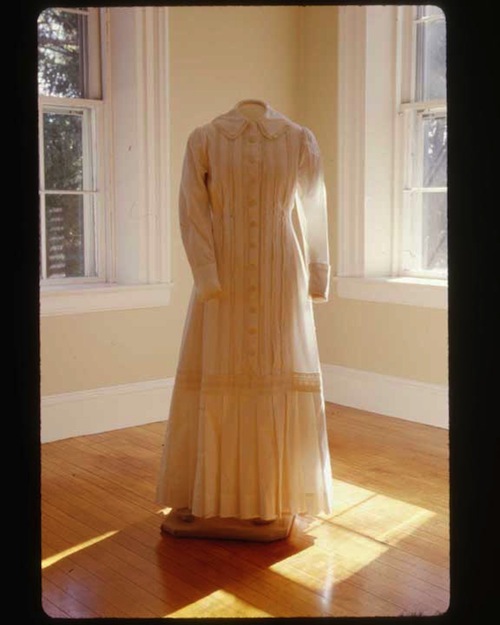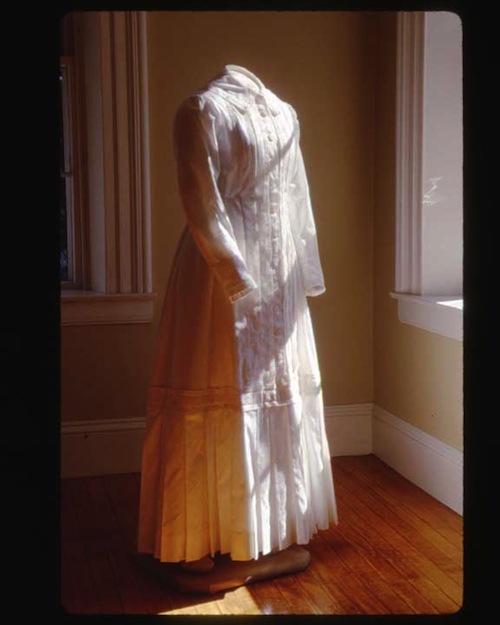Emily Dickinson Haunts the Poetry Foundation

The Poetry Foundation library is haunted by the ghost of Emily Dickinson these days. Or so it seems.
We've borrowed a copy of the poet's only surviving dress from the Emily Dickinson Museum in Amherst, Massachusetts as part of the current gallery exhibition, "Forever – is composed of Nows –," which features work by Jen Bervin, Marta Werner, Lesley Dill, and Spencer Finch.
The Dickinson Museum's executive director Jane Wald was kind enough to answer a few questions about the mysterious garment, which will be on display October 15 to November 30, 2013.
If you can't make it to Chicago, don't miss this video of the artists talking about their work.
***
Catherine Halley: How do we know this was Emily Dickinson’s dress? Where was it discovered?
Jane Wald: The original white dress—as far as we know, the only existing full garment belonging to Emily Dickinson—was given to a third cousin, Kate Hall Ives Porter by Lavinia Dickinson after her sister’s death. Kate then gave the dress to her sister Eugenia, who in turn passed it on to her daughter, Margaret Hunt Bradlee, who in 1946 gave the dress to the Amherst Historical Society. After 1965, the dress was loaned to the Dickinson Homestead for display in the poet’s bedroom. An exact replica, finished down to the slightest detail, was made in 1999 for the Dickinson Homestead.
Although we don’t know why the dress was given to the Halls, Emily Dickinson seemed to have a particular fondness for Eugenia. Some 35 years younger than Emily, she moved to Amherst in 1868 at the age of four to live with her grandfather. Several times in the last decade of her life, Emily, the “somewhat cousin” as she called herself, sent fond notes to Eugenia, the “little Cousin,” acknowledging exchanges of flowers and cakes between the two. Just months before her death, Emily sent Eugenia “a smile which will last a life” on her marriage in October 1885. It could be that the Dickinson sisters and Hall sisters shared a special bond which was the impetus for passing along one of Emily’s white dresses.
CH: Tell us about the style of dress—it’s been called a “house dress”—what does that mean? When would Emily Dickinson have worn it?
JW: In the nineteenth century, ladies wore comfortable clothes to tend to everyday activities – cooking, baking, cleaning, leisure – in the privacy of their own homes. When preparing to go out in public to shop, visit, attend church, or other activities outside the home, women wore more complicated garments that called for corsets, multiple petticoats, hoops, and other features as current fashions demanded. The former were known as “house dresses” or “wrappers.” By its style, we know that the white cotton pique dress given to Eugenia Hall dates to the last few years of Emily Dickinson’s life. With its multiple tucks, pleats, cuffs, and lace, it may have been a dress intended more for leisure within the home than for scrubbing and cleaning. Nevertheless, in the days before color-fast dyes, it was easier to keep clean than printed counterparts.
CH: Did Emily Dickinson always wear white? How do we know that?
JW: Because family members, visitors, and townspeople commented on Dickinson’s white attire, it’s sometimes assumed that Emily was always reclusive and wore white all her life, but we know that isn’t true. In a childhood portrait she wears blue, and in the famous daguerreotype made at age 16, she wears a dark print. Emily’s letters to her brother Austin show her shopping by mail for colorful prints and calicos. She was already thirty years old when she wrote a jesting letter to cousins pointing out that “my sphere is doubtless calicoes, nevertheless I thought it meet to sport a little wool. . . . Won’t you tell ‘the public’ that at present I wear a brown dress with a cape if possible browner, and carry a parasol of the same!”
Emily Dickinson seems to have adopted the habit of wearing white sometime in her thirties, for reasons we probably will never know. When Thomas Wentworth Higginson called on her at the Homestead in 1870, he was struck by her appearance as “a little plain woman with two smooth bands of reddish hair . . . in a very plain & exquisitely white pique & a blue net worsted shawl.” By the end of the decade, townspeople had grown accustomed to Dickinson’s preferred style of dress, but not so used to it that they didn’t gossip to newcomers, one of whom reported in 1881 that “she dresses wholly in white, & her mind is said to be perfectly wonderful.”

CH: How do people respond to the dress when they see it in the museum?
JW: Our replica of Dickinson’s white dress is displayed in the hall outside Emily Dickinson’s bedroom. It’s the first thing visitors see when they ascend the stairs, and if it’s a day when sunlight from the French doors behind put the front of the dress into shadow, it makes a powerful, almost animate impression. Many people come to the Emily Dickinson Museum in search of the poet behind the poetry, to find, if possible, a personal connection that will illuminate the source of such extraordinary art. Approaching the white dress, visitors often remark on the poet’s size and stature – the dress suggests that Dickinson was about 5’3.” This one physical fact seems to rescue Dickinson from a disembodied mythology and creates instead a new and reliable connection between the poet, her poetry, and themselves as readers.
CH: Anything else we should know about the dress?
JW: Theories abound as to why Emily Dickinson came to wear only white. She encountered characters in literature who wore white, including one of her favorites, Aurora Leigh, and white was a powerful symbol in her own poetry. Critics have ventured that, to her, white symbolized a spiritual commitment, or dedication to the vocation of poetry, or disappointment in and renunciation of earthly love. It’s likely that we’ll never fathom this choice. And would we really want to?
Catherine Halley is the editor of JSTOR Daily, an online magazine that draws connections between current affairs, historical scholarship, and other content available on JSTOR, a digital library of scholarly journals, books, and primary sources. She is the former digital director of the Poetry Foundation, where she served as editor of poetryfoundation.org.


